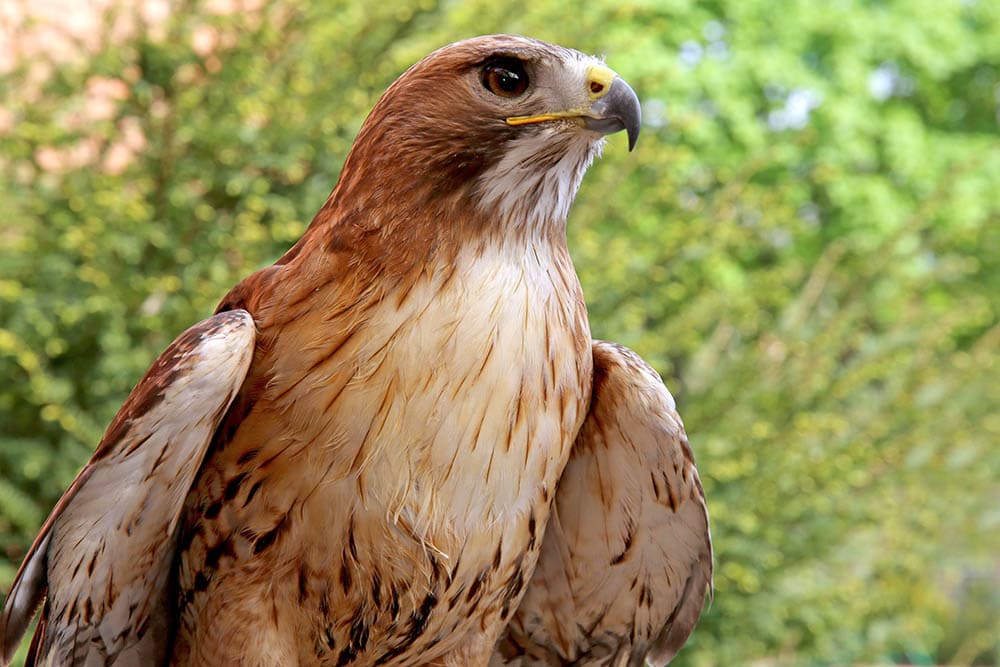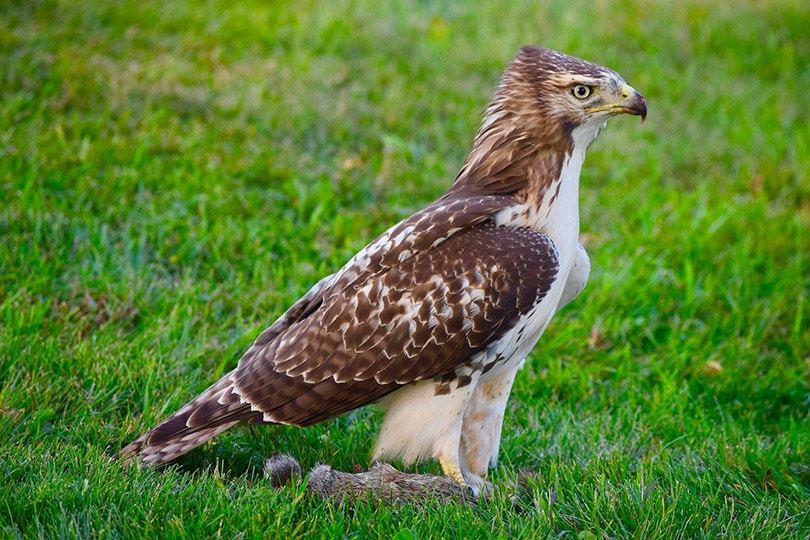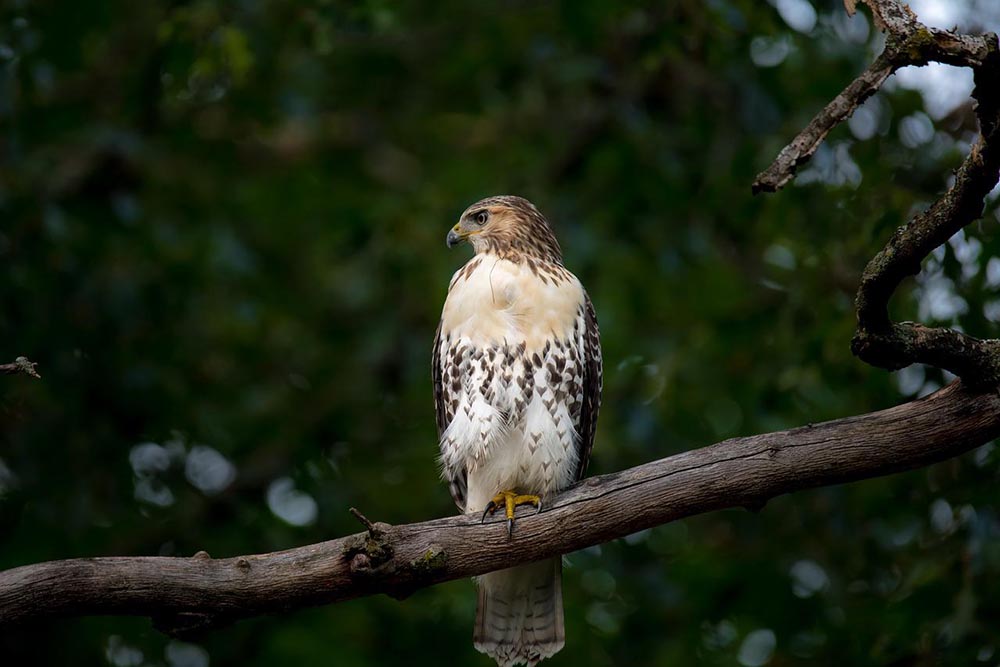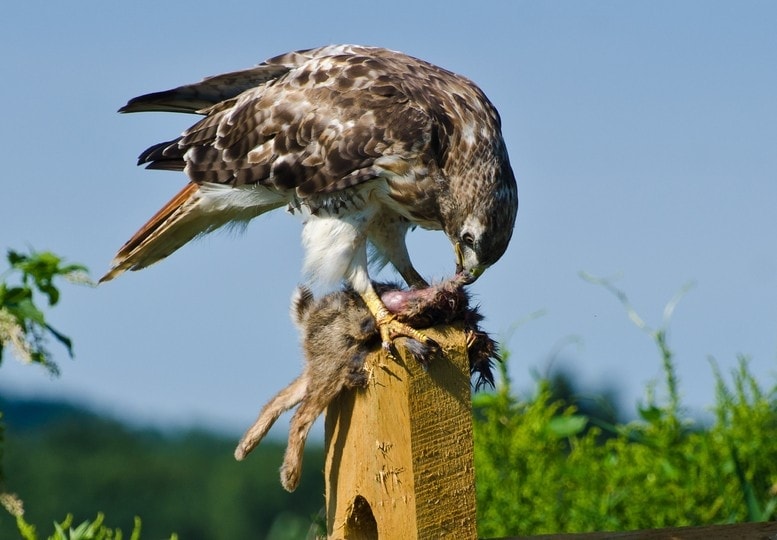Red-Tailed Hawk: Field Guide, Pictures, Habitat & Info
Last Updated on

The red-tailed hawk is one of the most common birds of prey in the US, but many people don’t know this because it’s difficult to identify one. Ordinarily, members of the same bird species are supposed to come in the same color plumage. But that’s not the case with the red-tailed hawk.
And even if you’re good at pointing out their individual colors, you’ll still have to deal with the physical variations.
There’s a lot to know about these hawks, so read on below to find out more about this beautiful raptor.

Quick Facts About the Red-Tailed Hawk
| Habitat: | Forests, marshes, deserts, & grassland |
| Diet: | Small mammals & birds |
| Behavior: | Territorial |
| Nesting: | Cliff Ledges & Tall tree crowns |
| Conservation: | Least Concern |
| Scientific Name: | Buteo jamaicensis |
| Lifespan: | 10–15 years |
Red-Tailed Hawk General Description
The “red” in red-tailed hawk is in reference to its rusty-red tail. But you won’t be able to spot that color on the younglings or the juveniles. The bird has to mature first, to get the full breeding plumage.
The red-tailed hawk’s scientific name is Buteo jamaicensis. Buteo is Latin that references the buzzard hawk, while ‘jamaicensis’ was meant to remind us all that the bird was first described in Jamaica.
It’s important to add that the red-tailed hawk has several other names. Some birders prefer calling it the red-tailed buzzard, hen hawk, buzzard hawk, or red eagle.

Red-Tailed Hawk: Range, Habitat, Behavior, Diet, & Nesting
Range & Migration
When we say the red-tailed hawk is one of the most common raptors on the continent, we don’t just mean in the United States. They are also found in the Caribbean, Canada, and Mexico. If you’ve visited all these regions, you’ll know they don’t share the same climate. This means we’re looking at a species that can easily adapt and thrive in any environment.
The red-tailed hawk is a partial migrant. And being “partial” means that some will remain behind, while others migrate. They are intelligent enough to understand that migrating has its fair share of risks. So a few of them will move to other parts of the country and leave the rest behind to battle the cold while surviving on what’s left in their depleting food stores.
During winter, the population living in the northern part of our country, and those in southern Canada, will move to warmer regions. The ones that will remain behind in that period will mostly be the breeding population. If you spot a red-tailed hawk migrating in autumn, chances are you’re looking at a juvenile. They are usually so excited to make the trip that they end up starting early.
This species likes to take advantage of favorable atmospheric conditions while migrating. They’ll work smart instead of working hard by beginning their migration across the broad front. The “broad front” is what we call the regions that have lighter winds where it’s easier for them to fly.
Don’t expect the red-tailed hawk to exhibit the same migratory behavior year in, and year out. That won’t happen, as they often read the situation and adapt appropriately. For example, if the winds are too strong, they’ll go with a different strategy. And the same applies if the temperatures drop.
High temperatures present more opportunities for thermal soaring, so they’ll stick to that.
Habitat
Their natural habitats are those defined by forests, marshes, deserts, and grassland. But because of climate change and human encroachment, they’ve had to learn how to live among us. Blending into our society wasn’t a tall order for them, considering our environments provided the three basic things that characterize an ideal habitat: food, water, and shelter.

Behavior
There are few bird species as territorial as the red-tailed hawk. We know nearly all birds of prey are territorial, but this one takes it a notch higher. To get to their nest, you’ll have to get past two levels of security.
Half the time, the male will be soaring, trying to spot an intruder. And while he does that, the female will keep an eye out for anyone or anything creeping from below. Together, they cordon off an area of 2 square miles.
Diet
The red-tailed hawk is without a doubt a carnivorous raptor. You’ll never find it foraging for seeds, fruits, or greens because it loves to hunt reptiles, other bird species, and medium-sized mammals. They’ll only resort to insects if their food stores are running low due to freezing temperatures.
You’ll know the hawk is stalking its prey when it’s perched up high on a pole or tree, looking down. And when they are ready to pounce, they’ll swoop down at crazy speeds and grab prey before it gets the chance to escape.
They are also notoriously known to hunt while soaring. Flying over an agricultural field infested by rodents allows it to spot one that’s oblivious to its surroundings.
Nesting & Breeding
Soaring is not just important for migration, but for breeding as well. You see, these flight plays are supposed to help the bird scout its nesting territory and protect it. Red-tailed hawks that migrate practice aerial courtship before they get to their destination. Taking into account the fact that they stay monogamous throughout the year they’ll soar the skies in pairs and at high altitudes.
They’ll only build a nest if they are part of the group that’s moving. The guys left behind will refurbish an old one, using branches that are a couple of feet long and an inch thick. Unlike most bird species, the male will work in tandem with his partner to build a comfortable nest. And they are often very covert with their operations, for some reason. If they spot you lurking, or any other intruder, they’ll abandon that site and look for a different one elsewhere.
The ideal nesting site is above ground, with a clear line of sight. This ensures nothing preys on their eggs and they can quickly spot an enemy approaching from a distance. If you’re in a forest, look for the nests on top of the trees or at the cliffs. Suburban dwellers can find one on the power line towers, or any other human construction that looks secluded.
A typical red-tailed hawk clutch will have one to five eggs. If the conditions are right, and they feel like laying more than an egg, they’ll lay the next one after 48 hours. Incubation normally takes 4–5 weeks, with the female running points. The male will ensure she gets enough food and is always well protected.
Once the eggs hatch, the nestlings will be fed and protected from the cold for 5 weeks. After that period elapses, they’ll be taught how to fly and hunt for themselves, for another 5–7 weeks. By the time they are ready to be independent, they have moved out of their nests completely, with improved flight ability.

How to Find Red-Tailed Hawks: Birdwatching Tips
What to Listen For
There’s a “kreeeeeeeer” sound that we often hear in movies whenever a raptor descends upon its prey. Well, we want you to know that that sound can only be produced by this bird. So if you hear it out there, don’t mistake it with that of a falcon, a crow, or any other species.
Other times, they’ll produce a scolding “screeee” call, especially while trying to defend its territory or a high-pitched begging call. Needless to say, that begging call is often used by the nestlings, looking to grab their parent’s attention.
What to Look For
As we’ve already noted, identifying this species can present itself as a challenge to the untrained eye. Even though they are so common and widespread, some of them have a dark coloration, some come in white shades, and others are very light.
Red-tailed hawks might look different, but all of them have bills that are large, hooked, and have a yellow cere at their base. Both the males and females have upper parts that have brown mottling but don’t rely on the white colorations too much, which varies from one bird to the next.
If you look at the wings, they’ll be brown at the top but lighter on the other side. All their tails are obviously rust-red (unless you’re looking at a juvenile, who’ll develop some once it turns two) and the head is lighter brown. Their abdomens usually have brown streaks, their feet are yellow, and their chests are white.
Red-tailed hawks exhibit sexual dimorphism. This is the phrase used to describe the difference in the physical form of individual sexes of the same species. Most animals have males being larger than their counterparts, but in the case of the red-tailed hawk, the females are usually larger.
Researchers believe their different rates of maturity could be the reason that is, but some ornithologists believe it’s because the females protect the young ones—size matters in the animal kingdom.
The males are also just as fierce, but not as fierce as their spouses when it comes to protecting their nestlings.
When to Look
The red-tailed hawk is not a nocturnal species. If you’d like to study one in its natural habitat, go out during the day. That’s when they are most active because they can easily take advantage of their extra-sharp vision.

Attracting Red-Tailed Hawks to Your Backyard: Tips & Tricks
Are you looking to befriend a red-tailed hawk? If you’d like them to pay you a visit, just do this:
- Make your yard a rodent-hub
- Install stable perches
- Provide bathing water
- Grow more trees to act as nesting sites
- Make sure your landscape looks undisturbed
- Keep the yard quiet
Red-tailed Hawk Conservation: Is this Bird Threatened?
From our research, the red-tailed hawk is not considered endangered or threatened by the International Ornithology Committee (IOC) or by the International Union for Conservation of Nature (IUCN). Nonetheless, they are still susceptible to the harmful effects of the chemicals used in the production of rodenticides and pesticides.
There’s no way the bird can differentiate contaminated prey from safe ones. And once that chemical gets into their system, it compromises their avian immune system and even affects eggs being laid. The shells are usually weak, and hence, break during incubation.

Conclusion
Not very many people have successfully attracted red-tailed hawks to their yards. These birds are very intelligent and can easily spot a setup when they see one. So don’t feel bad if you’ve done everything by the book, and still haven’t seen anything for weeks. But if you’ve been lucky, pat yourself on the back and enjoy the incredible insights into the avian world.
Featured Image Credit: acceptphoto, Shutterstock
Table of Contents
- Quick Facts About the Red-Tailed Hawk
- Red-Tailed Hawk General Description
- Red-Tailed Hawk: Range, Habitat, Behavior, Diet, & Nesting
- How to Find Red-Tailed Hawks: Birdwatching Tips
- Attracting Red-Tailed Hawks to Your Backyard: Tips & Tricks
- Red-tailed Hawk Conservation: Is this Bird Threatened?
- Conclusion
About the Author Robert Sparks
Robert’s obsession with all things optical started early in life, when his optician father would bring home prototypes for Robert to play with. Nowadays, Robert is dedicated to helping others find the right optics for their needs. His hobbies include astronomy, astrophysics, and model building. Originally from Newark, NJ, he resides in Santa Fe, New Mexico, where the nighttime skies are filled with glittering stars.
Related Articles:
Binocular Magnification Chart: Numbers & Distances Compared
10 Types of Hummingbirds in Arkansas (With Pictures)
8 Types of Hummingbirds in Nebraska (With Pictures)
5 Types of Hummingbirds in Idaho (With Pictures)
3 Types of Hummingbirds in Mississippi (With Pictures)
8 Types of Hummingbirds in Kansas (With Pictures)
5 Types of Hummingbirds in West Virginia (With Pictures)
5 Types of Hummingbirds in Ohio (With Pictures)
